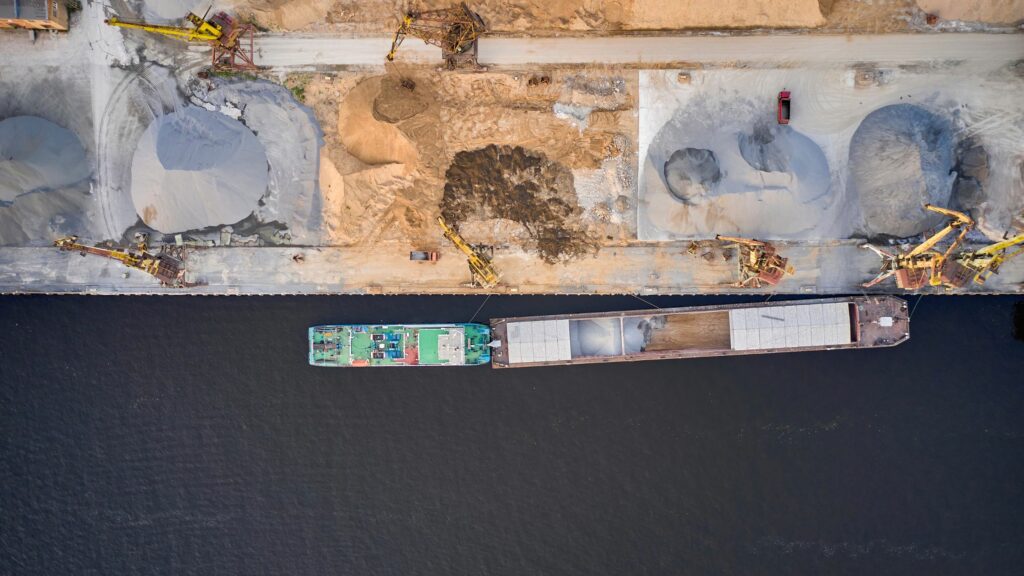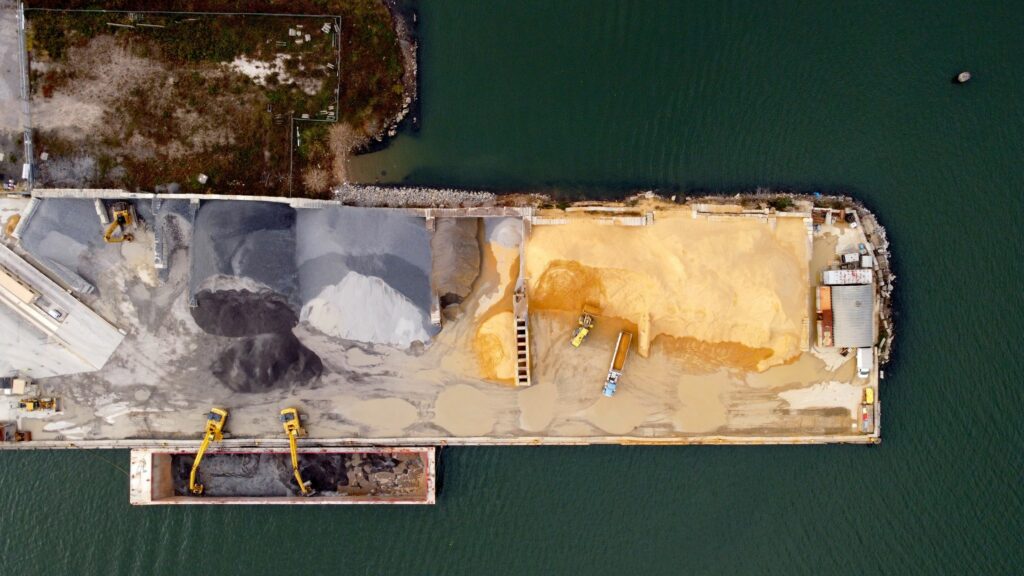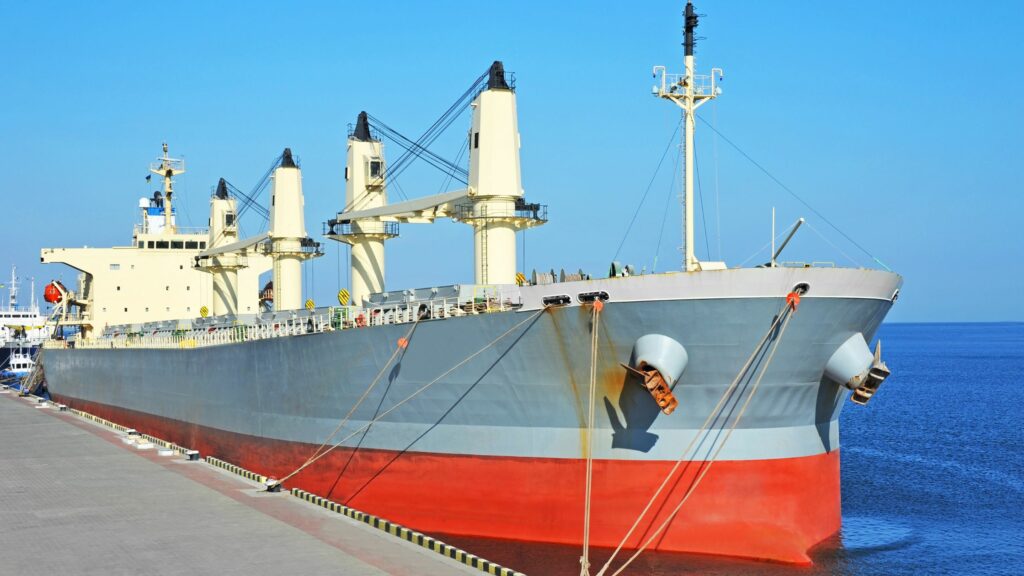Physical Address
304 North Cardinal St.
Dorchester Center, MA 02124
Cement clinker serves as a vital component in the construction industry, playing a crucial role in the production of cement. Understanding its properties and transportation methods enhances efficiency in construction and infrastructure projects globally.

The bulk shipping of cement clinker involves large-scale transport using specialized vessels to meet demand. Significant factors include the stowage factor, which determines the volume occupied by the clinker, and the various types of cement products that can be shipped, such as jumbo bags and paper bagged cement.
Cement clinker is an unground cement essential for Portland cement production. It results from sintering limestone and alumino-silicate (clay) in a cement kiln. The sintering process forms nodules, typically ranging in size from 3 to 25 mm in diameter.
Clinker serves as the primary ingredient in Portland cement. Manufacturers grind it with gypsum or other substances like slag or pozzolan to produce various cement types. Its ability to be stored for several months under dry conditions makes it ideal for bulk transport and international trade. The clinker maintains quality over extended periods during storage.
Bulk shipping of clinker involves conventional bulk carriers. These ships use air to fluidize the cargo, facilitating easier management during loading and unloading processes. This specialized handling method ensures efficient transport of bulk materials across global markets.
For clarity, here is a quick summary of essential points:
These characteristics make cement clinker a valuable and efficiently-transported raw material in the cement industry.
Bulk shipping of cement clinker represents a critical link in the global cement trade. This process involves transporting large volumes of cement clinker, a semi-manufactured material essential for cement production. It is produced through the heating of raw materials like limestone and clay.
Specialized carriers are used for this task. Pneumatic cement carriers, for instance, use advanced systems for loading and unloading cement efficiently while minimizing contamination risks. Conventionally, bulk carriers also employ aeration techniques. Here, air pumps through the cement cargo, treating it as a liquid for smoother loading and discharge.
Unloading requires specialized equipment to minimize dust and environmental contamination. The equipment ensures safe transfer to storage or distribution systems. Managing these processes efficiently is vital for maintaining the cement’s quality and compliance with environmental regulations.
By transporting cement clinker in bulk, the industry supports vast infrastructure projects worldwide. This method enables the swift and safe delivery of essential materials, bridging manufacturers and consumers globally. The entire operation demands meticulous attention to the loading and unloading processes, completion, and environmental factors to remain effective and safe.
The stowage factor in shipping refers to the volume taken by a ton of cargo, expressed in cubic meters per ton (m³/t). For bulk cement, this factor typically ranges from 0.61 to 0.64 m³/t, which indicates the space needed in a ship’s hold for efficient loading.
Bagged cement must be stowed appropriately to avoid damage, emphasizing the stowage approach’s role in minimizing risk and ensuring safety. Loose bulk cement, with a stowage factor of 25 to 30 cubic feet per metric ton (cbft/MT), further demonstrates volume efficiency during transport.
Proper management of the stowage factor is crucial. It influences ship balance and safety, particularly concerning dust explosion risks and potential cargo shift. Understanding and utilizing stowage factors effectively can enhance the capacity and safety of bulk shipping operations.
Cement clinker serves as the foundational material for cement production. Ground into a fine powder, it creates ordinary cement. Ordinary Portland Cement (OPC) is highly prevalent in construction due to its diverse strength grades, typically measured in megapascals (MPa) after 28 days of curing. Portland Pozzolana Cement (PPC), a blended variant, includes pozzolanic materials. These additives enhance strength, durability, and chemical resistance.
The making of OPC begins with raw materials like limestone and clay. These are heated to yield clinker, which is then mixed with gypsum for the final product. Different cement types, hydraulic and non-hydraulic, possess unique characteristics. Hydraulic cements harden via hydration, while non-hydraulic types require dryness to retain strength.
Jumbo Bags, also known as Big-Bags, are constructed from polypropylene or PVC-coated polyester. Their capacity ranges from 1 to 1.5 metric tonnes, with heavy-duty versions supporting up to 3 tonnes. Designed for durability, these bags can endure multiple uses over several years, providing climate-resistant transport solutions for cement.
The advanced heavy-duty Jumbo Bags offer enhanced reliability over traditional polypropylene variants. Plastic straps facilitate lifting, simplifying handling during shipping and unloading. They represent an efficient alternative to paper sacks, streamlining logistics in cement transport.
Traditional paper sacks for cement can be palletized and shrink-wrapped into units between 1.5 and 2.5 tonnes. This packaging method aids handling when suitable equipment is available at both loading and unloading locations. The primary aim of paper sack packaging is to shield cement from moisture and contamination during transit.
Proper storage is vital, necessitating protection from water and dampness and placement on flat surfaces to prevent splitting. Pallets and shrink wrapping enhance bagged cement’s protection during shipping. If exposed to seawater or heavy rain, bags may harden, forming lumps at corners, though unaffected powdered cement within remains usable.
Cement clinkers result from sintering limestone and alumino-silicate in cement kilns, forming nodules of 3-25mm diameter. When ground with materials like gypsum, slag, and pozzolan, clinker produces various cement types tailored for specific applications. Under dry storage, clinker maintains quality for months, boosting its trade appeal. For instance, low heat cement features clinker with reduced tricalcium aluminate, yielding less heat during hydration and reducing thermal cracking risks. Sulphate resisting cement is crafted with clinker low in tricalcium aluminate, enhancing resistance to sulphate attacks, ideal for structures exposed to sulphate-rich environments.
Cement clinker is often shipped in bulk cargo vessels. Specialized handling is essential to avoid contamination from seawater or other materials. Packaging in specialized containers ensures safe transportation and intact delivery. These containers protect the clinker during its sea journey.

Remote control trimming systems improve the loading process and maximize hold space. The systems enhance average loading rates, making the shipping process more efficient. Upon arrival at the destination port, the clinker is efficiently unloaded. Shore-side cranes transfer the cargo into handling systems like the SAMSON Eco Hopper.
The SAMSON Eco Hopper system efficiently handles unloading rates up to 5,000 tonnes per hour. Its design minimizes product loss and contamination during discharge. High-capacity equipment like the Eco Hopper is crucial for the smooth import of cement clinker. Specialized packaging, strategic loading techniques, and modern unloading systems together ensure the safe and efficient carriage of cement clinker across seas.
Loading bulk cement clinker onto ships requires specialized equipment. Blowers or air compressors pump the cement into cargo holds via pipes and hoses. Cement is typically loaded as powder or granules, demanding careful handling to minimize dust and prevent contamination.
Cargo holds must be dry, tightly sealed, and condensation-free before loading. Moisture can cause cement to crust or lump, necessitating disposal of the affected material. The stowage factor for bulk cement is between 0.61 to 0.64 m³/t, determining cargo space utilization efficiency. Proper pre-loading preparations are crucial for effective transport.
The unloading process starts with a clean, dry unloading area. This reduces obstructions and supports smooth removal operations. Proper vessel positioning alongside the dock facilitates container lifting using equipment like cranes or forklifts.
Careful unloading is important to avoid damage and ensure the safe transportation of containers to the destination facility. Availability of suitable port facilities is crucial for effective unloading of cement clinker. Close monitoring throughout helps maintain cargo integrity and ensures operational safety.
Bulk transportation of cement clinker demands specialized vessels. These vessels must be equipped with handling equipment to prevent contamination from seawater and other contaminants. Cement clinkers are usually transported in bulk cargo vessels, posing significant challenges in maintaining material integrity. Furthermore, loading and transit account for roughly 5% of dry bulk trade, leading to residue accumulation in ship holds and complicating cleaning processes.
Temperature monitoring is essential during loading. High temperatures exceeding 80°C should be reduced to avoid risks. Accurate packaging and effective temperature control are critical in the handling process. Conventional ships can have hard-to-reach areas, making cleaning laborious.
Moisture control is vital during cement shipment and storage. Exposure to humidity can lead to surface solidification, degrading the cement cargo. During transport, water vapor condensation can occur, especially when cement is loaded in warm and humid conditions. Close monitoring of the dew point and temperatures of incoming air and steel prevents condensation issues.
Proper unloading is essential to prevent moisture-induced solidification. Maintaining high moisture content during the curing process benefits the final strength, showing the importance of moisture control in cement handling. Monitoring air conditions during unloading ensures the cargo remains dry.
Fortunately, moisture controls are required for many other goods such as agricultural products, some metals and grains.
Supervision of the bulk cement loading process is critical. Compliance with the stowage plan and regulations reduces risks of mishandling. Cement cargoes must be properly secured during voyages, which may include adjusting the ship’s ballast and trim. Additional measures may also be required to prevent damage.
Before loading, cargo holds require thorough preparation and cleaning. Ensuring holds are dry and residue-free from previous cargoes prevents contamination. During unloading, management must address risks of moisture exposure to protect cargo integrity. Compliance with maritime regulations throughout this process is crucial to maintain safety and avoid legal issues.
Specialized equipment like blowers and air compressors facilitate the loading of bulk cement onto ships. These tools move the cement through pipes and hoses efficiently. Bulk cement has a high-density profile with a low stowage factor ranging from 0.95 to 1.05 m³/MT. Self-discharging vessels enhance unloading procedures at ports, leading to improved logistics.
Safety in cement shipping involves preventing dust explosions and cargo shifts. Proper ventilation and dust suppression systems are crucial. Adhering to strict safety procedures ensures safe handling throughout transportation, essential for the carriage of powdered materials.
Pneumatic cement carriers, designed for powdered forms, boost transportation efficiency with self-discharging systems. Specialized cargo holds and equipment manage material movement efficiently. Loading involves blowers or air compressors, minimizing dust release through an organized pipe network.
During unloading, cranes or forklifts safely remove cement, ensuring secure delivery to storage facilities. Bulk cement’s high density and low stowage factor, from 0.95 to 1.05 m³/MT, necessitates precise handling to maintain stability during transit and discharge operations.
Customized storage for cement involves cement storage silos, preventing contamination and managing dust effectively. These solutions accommodate stowage factors from 0.61 to 0.64 m³/t, optimizing space. Specialized containers prevent contamination during shipping, safeguarding cement clinkers.
Protecting bagged cement from moisture is crucial. Pallets and shrink wrapping shield against damp conditions, maintaining cement’s usability. Proper ventilation and dust suppression mitigate risks during transportation and storage, ensuring the integrity of bulk cement materials.
International regulations for cement shipping prioritize safety and efficiency. Compliance with global standards ensures that cement cargoes transit without compromising vessel stability. Relevant authorities regularly update these regulations to address evolving industry trends and technological advancements.
The International Maritime Solid Bulk Cargoes (IMSBC) Code provides essential guidelines for bulk cargoes, including cement. It categorizes these cargoes into three groups: A, B, and C. Each group’s properties and hazards dictate specific handling procedures and safety measures.
Shipping companies must comply with the IMSBC Code during voyage planning. Adherence minimizes risks, addresses navigational hazards, and ensures the safe transport of bulk cement cargoes. The Code also outlines shippers’ responsibilities and required documentation for solid bulk cargoes.
Cement shipping routes serve critical functions in global cement trade. Major routes include Asia-Pacific to the Middle East due to rising construction demands. Southeast Asia also exports to North America and Europe, supported by advanced loading ports. Europe notably imports bulk cement from Eastern Europe and North Africa, regions rich with cement raw materials like limestone and clay.
The Mediterranean Sea acts as a central shipping hub. This route connects Europe to North Africa and the Middle East. The Suez Canal further facilitates cement trade between Asia and Europe. Operators employ specialized equipment for efficient bulk cement loading and unloading at these busy ports.
The Atlantic routes feature South American cement exporters accessing markets in North America and Europe. Cement carriers, designed for climate-proof transport, traverse these waters regularly. Shore-side cranes and geared vessels unload cargo efficiently at destination ports, ensuring rapid distribution. These routes illustrate key logistical chains in the cement industry.
Spain, India, Thailand, and Iran rank among the top cement exporting countries. Spain’s cement industry benefits from extensive production capacity, making it a leading exporter in the European Union. With large limestone reserves, India dominates export markets in South Asia, the Middle East, and Africa.
Thailand, situated in Southeast Asia, capitalizes on its robust cement industry and abundant limestone resources to serve regional demand. Iran, with its well-developed industry, reaches markets across the Middle East, Central Asia, and Africa. These countries use their production capabilities effectively to meet global cement needs.
Top Cement Exporters and Key Markets:
These nations harness their natural resources and production facilities efficiently to maintain a strong presence in the global cement market.
Transporting clinker in bulk necessitates specialized equipment to avert contamination from seawater and airborne pollutants. This includes the use of SAMSON Material Feeders integrated with Shiploaders. Such setups enable continuous ship loading, improving efficiency while significantly reducing dust at transfer points.
The employment of ecological hoppers and carefully designed shiploaders is vital. These systems limit dust and minimize material spillage effectively during loading and unloading processes. To further enhance protection, clinker must be packaged in specialized containers for sea transportation. This packaging method addresses bulk transport challenges and mitigates risks associated with contamination from previous shipments.
Containerization of clinker simplifies handling large quantities. It reduces logistical complexities and ensures that the integrity of the semi-manufactured material remains intact throughout transit. By implementing these measures, companies ensure safe and efficient transportation of cement clinker.
Proper ventilation and dust suppression systems are essential in cement shipping. These measures mitigate environmental risks and minimize dust generation during handling. Ensuring that pneumatic cement carriers have advanced systems allows for efficient loading, stowage, and unloading with minimal environmental impact.

Managing the unloading process carefully is crucial to prevent dust generation and contamination. Efficient systems in pneumatic carriers facilitate this, highlighting their importance in reducing environmental harm. Cleaning cargo holds is vital when transitioning from materials like sugar to cement. This process prevents contamination and underscores the need for thorough inspection and sanitation.
The presence of chemicals such as ammonia can alter cement’s character. Therefore, careful stowage and handling ensure environmental safety and product integrity. This necessity emphasizes the importance of trained personnel and proper equipment for cement shipping. Implementing these environmental considerations protects both the ecosystem and the quality of the transported cement.
Clinker can be transported using various methods, depending on the distance and destination. For shorter distances, trucks are commonly employed, providing flexibility and direct access to construction sites or local cement plants. However, for longer distances, particularly international shipments, rail and ocean freight are favored. These methods are not only more cost-effective but also align with environmental sustainability goals by reducing the carbon footprint associated with road transport.
Clinker is a nodular material produced during the cement manufacturing process, specifically in the kilning stage. It consists of hard, granular particles typically measuring between 3 to 25 mm in diameter. The production involves heating limestone and clay at high temperatures (about 1400°C to 1500°C) in a rotary kiln. Once produced, clinker serves as the primary ingredient for various cement products when ground with gypsum to control setting properties
In shipping terminology, clinker refers specifically to the unground product that is transported before it is processed into cement. Unlike cement powder, clinker does not contain binding agents that cause it to harden upon contact with water, making it somewhat easier to handle during transport. However, it still requires dry conditions to prevent caking and contamination
The largest producer of clinker globally is China, followed by significant contributions from countries like India, the United States, Turkey, and various European nations. These countries dominate both production and export markets due to their extensive cement manufacturing industries